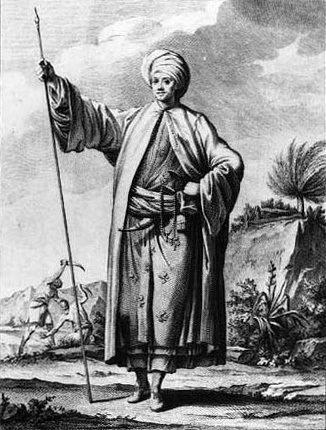Native name Den Arabiske Rejse Type Expedition | Location Middle East Patron(s) Frederik V of Denmark | |
 | ||
Duration 7008216993600000000♠6 years, 320 days Date January 4, 1761 – November 20, 1767 (1761-01-04 – 1767-11-20) | ||
The Danish Arabia expedition (Danish: Den Arabiske Rejse) was a Danish scientific expedition to Egypt, Arabia and Syria. Its principal goal was to elucidate the Old Testament with additional research goals concerned with natural history, geography and cartography. It had six members of whom only Carsten Niebuhr survived, returning to Denmark in 1767. The journey has been chronicled by Thorkild Hansen in his novel Arabia Felix.
Contents
The expedition
The expedition departed from Copenhagen in 4 January 1761, and, landing at Alexandria, ascended the Nile. Proceeding to Suez, from where Niebuhr made a visit to Mount Sinai, in October 1762 the expedition sailed to Jeddah, and then journeyed overland to Mocha. Here, in May 1763, the expedition's philologist, von Haven, died, and shortly afterwards its naturalist Peter Forsskål also died. The remaining members of the expedition visited Sana, the capital of Yemen, but suffered from the climate and returned to Mocha. Niebuhr seems to have preserved his own life and restored his health by adopting native dress and eating native food. From Mocha the expedition continued to Bombay, the expedition's artist dying en route and the surgeon soon after landing. Niebuhr was now the only surviving member. He stayed in Bombay for fourteen months and then returned home by way of Muscat, Bushire, Shiraz and Persepolis. His copies of the cuneiform inscriptions at Persepolis proved to be a key turning point in the decipherment of cuneiform and the birth of Assyriology. He also visited the ruins of Babylon (making many important sketches), Baghdad, Mosul and Aleppo. He seems also to have visited the Behistun Inscription in around 1764. After a visit to Cyprus he made a tour through Palestine, crossed the Taurus Mountains to Brussa, reached Constantinople in February 1767 and finally arrived in Copenhagen the following November.
Members of Expedition
Six people went on the expedition, with five of them dying. † denotes which members died on the expedition.
